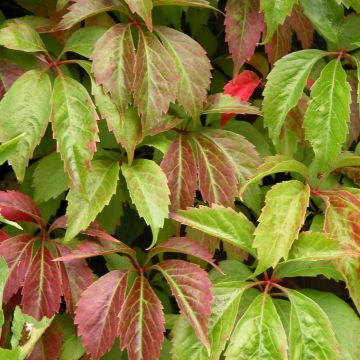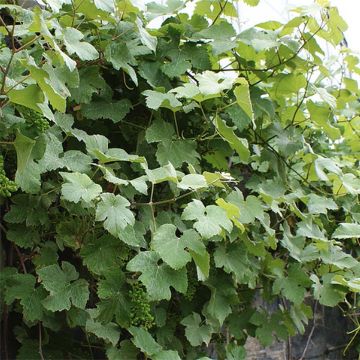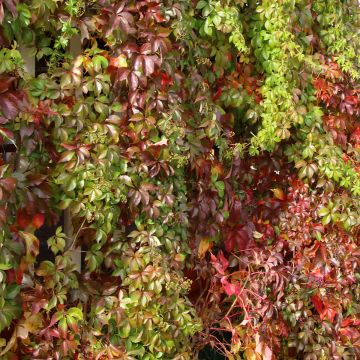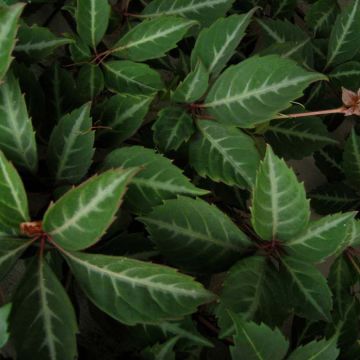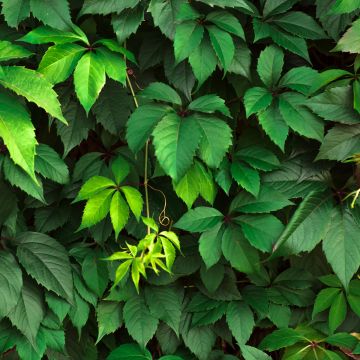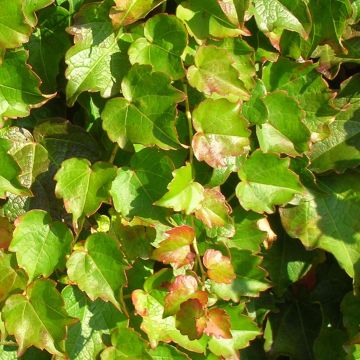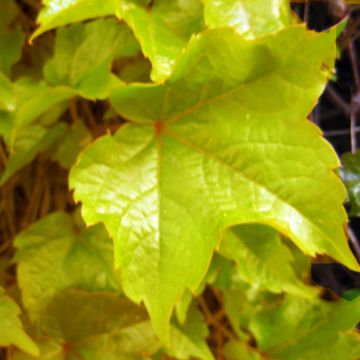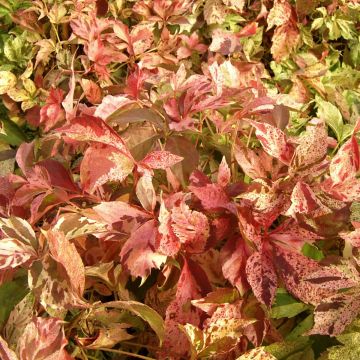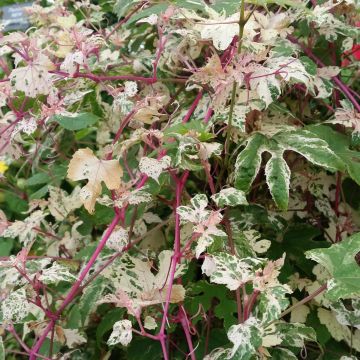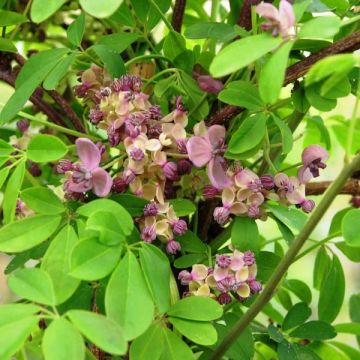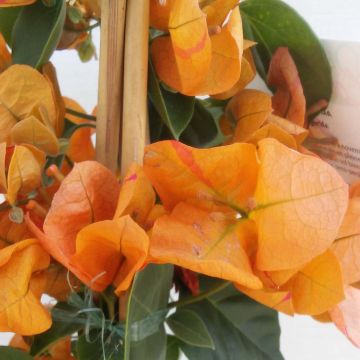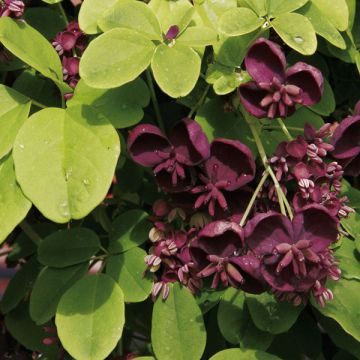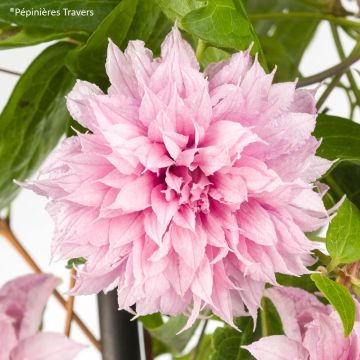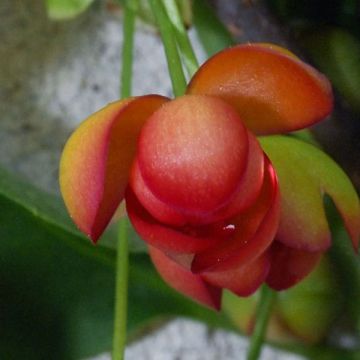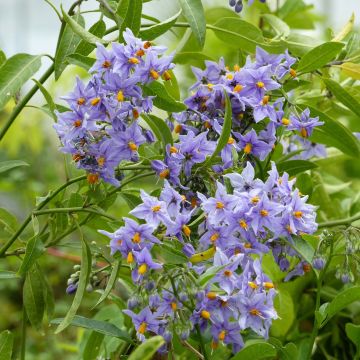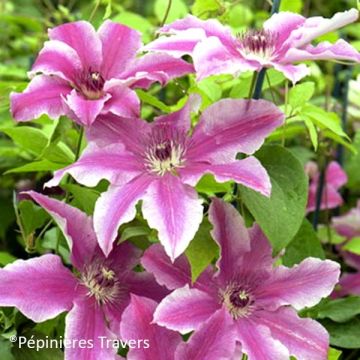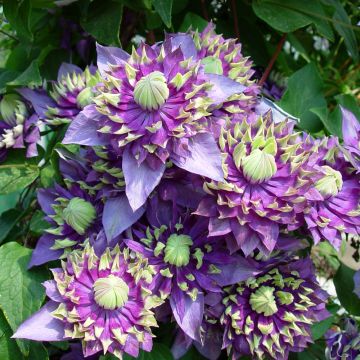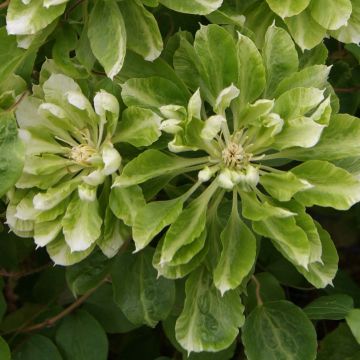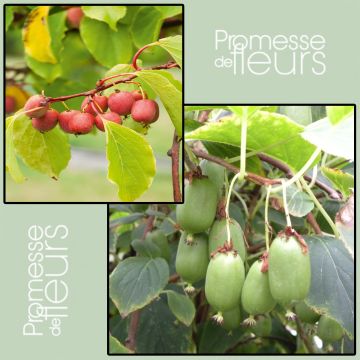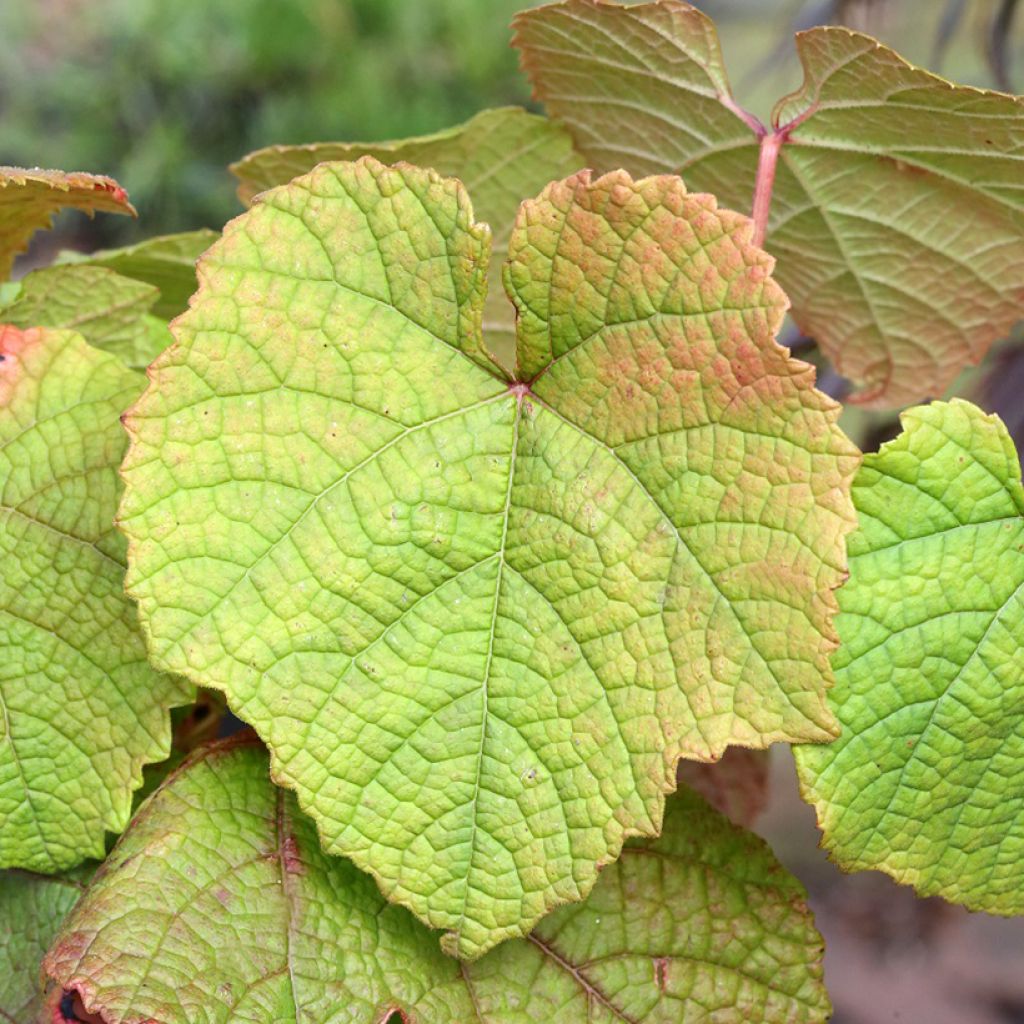

Vitis riparia
Vitis riparia
Vitis riparia
Riverbank Grape, Frost Grape
This item cannot be shipped to the selected country
Delivery charge from €5.90
More information
Schedule delivery date,
and select date in basket
This plant carries a 6 months recovery warranty
More information
We guarantee the quality of our plants for a full growing cycle, and will replace at our expense any plant that fails to recover under normal climatic and planting conditions.
From €5.90 for pickup delivery and €6.90 for home delivery
Express home delivery from €8.90.
Does this plant fit my garden?
Set up your Plantfit profile →
Description
Vitis riparia (synonyms V. odoratissima, V. vulpina or V. cordifolia), commonly known as frost grape or riverbank grape, is a beautiful wild vine native to North America, introduced to France as a rootstock for its resistance to phylloxera, a formidable parasite that decimated the French vineyard in the 19th century. It is also used as an ornamental climbing plant because it produces a sour black grape of poor taste. In early summer, its cream-white flowering, in vaporous clusters, is both melliferous and pleasantly fragrant. Its grapes ripen in September, somewhat softened by the autumn frost, and are used to make jellies in North America. It is appreciated for its hardiness, its charm as a wild plant, and its beautiful autumn colours. Very hardy and not demanding in terms of soil, it thrives in the sun and prefers loamy, fertile soils.
Riverbank grape belongs to the vitaceae family. Native to eastern North America, it grows spontaneously from southern Canada to Oklahoma and Arkansas. It has naturalised in the Mediterranean region where it hybridizes with wild grape (Vitis vinifera subsp. sylvestris). Many hybrids have been created to vary u, flavours, and uses. Frost grape is a vigorous, fast-growing sarmentous shrub, capable of living for many years in the garden. This fast-growing plant can send its stems up to 18-20 metres (59-66 feet) depending on growing conditions. It spreads both by its seeds, dispersed by birds, and by producing shoots. Its final shape will depend on the pruning practiced. The vine attaches itself to its support (trellis, espalier, etc.) thanks to its tendrils and prefers sunny locations. The foliage of Vitis riparia is deciduous, appearing in spring and falling in autumn. The heart-shaped leaves, 7 to 15 cm (3 to 6in) long, have toothed edges. They sometimes have 3 slightly marked lobes. The lamina is medium green, turning orange to red tones in autumn. This species is dioecious: there are male and female plants. Only the females produce fruits. Flowering occurs in June, often as early as May in mild climates. Panicles of 5 to 15 cm (2 to 6in) long, composed of numerous tiny cream-coloured flowers with a sweet fragrance, form at the leaf axils. After pollination, grapes form in small clusters, more or less tightly packed together. These round grapes, 9 mm (<1in) in diameter, start off green and ripen in September-October, earlier in the south than in tnorthern or central regions. They are blackish-blue when ripe, with thick and powdery skin. The pulp is very acidic and contains seeds. Any other vine that flowers at the same time can pollinate it.
Resistant to mildew and phylloxera, this vine avoids repeated treatments and promotes biodiversity in the garden. It is indifferent to soil types but thrives in deep, loamy, and fertile soils. Riverbank grape climbs willingly on any available support: it covers fences, climbs over walls, reaches into trees, and quickly adorns facades, arbors, and pergolas. It pairs well with Virginia creeper, large mountain clematis, or wisterias.
The grapes of this vine can be eaten as table fruit after being exposed to frost, but they can also be used for jam, jelly, pastries, and wine. The frost grape provides food for bees and birds that nest in its vegetation, as well as for the red fox, which does not disdain the fallen grapes on the ground.
Report an error about the product description
Plant habit
Flowering
Foliage
Botanical data
Vitis
riparia
Vitaceae
Riverbank Grape, Frost Grape
North America
Other Parthenocissus - Virginia Creeper
Planting and care
The Vitis riparia should be planted in early spring or autumn. This plant is not very demanding in terms of soil, although it prefers loamy, rich, and slightly moist soils. Plant it in a slightly acidic, neutral, or even limestone soil, deep, loose, rather moist, which you will have enriched with an organic fertiliser. Choose a semi-shaded or sunny exposure, the autumn colour will be more intense in full sun and the fruits less acidic. It can withstand temperatures as low as -25°C (-13°F) and moderate periods of summer drought once it is well rooted. Prune it in February by cutting it back quite severely. You can train it to support and guide the branches. This vine can spread by layering or by producing suckers in favorable conditions. And birds, which are fond of its grapes, can scatter it in the garden, at the foot of hedges or perching trees.
Planting period
Intended location
Care
This item has not been reviewed yet - be the first to leave a review about it.
Unusual climbers
Haven't found what you were looking for?
Hardiness is the lowest winter temperature a plant can endure without suffering serious damage or even dying. However, hardiness is affected by location (a sheltered area, such as a patio), protection (winter cover) and soil type (hardiness is improved by well-drained soil).

Photo Sharing Terms & Conditions
In order to encourage gardeners to interact and share their experiences, Promesse de fleurs offers various media enabling content to be uploaded onto its Site - in particular via the ‘Photo sharing’ module.
The User agrees to refrain from:
- Posting any content that is illegal, prejudicial, insulting, racist, inciteful to hatred, revisionist, contrary to public decency, that infringes on privacy or on the privacy rights of third parties, in particular the publicity rights of persons and goods, intellectual property rights, or the right to privacy.
- Submitting content on behalf of a third party;
- Impersonate the identity of a third party and/or publish any personal information about a third party;
In general, the User undertakes to refrain from any unethical behaviour.
All Content (in particular text, comments, files, images, photos, videos, creative works, etc.), which may be subject to property or intellectual property rights, image or other private rights, shall remain the property of the User, subject to the limited rights granted by the terms of the licence granted by Promesse de fleurs as stated below. Users are at liberty to publish or not to publish such Content on the Site, notably via the ‘Photo Sharing’ facility, and accept that this Content shall be made public and freely accessible, notably on the Internet.
Users further acknowledge, undertake to have ,and guarantee that they hold all necessary rights and permissions to publish such material on the Site, in particular with regard to the legislation in force pertaining to any privacy, property, intellectual property, image, or contractual rights, or rights of any other nature. By publishing such Content on the Site, Users acknowledge accepting full liability as publishers of the Content within the meaning of the law, and grant Promesse de fleurs, free of charge, an inclusive, worldwide licence for the said Content for the entire duration of its publication, including all reproduction, representation, up/downloading, displaying, performing, transmission, and storage rights.
Users also grant permission for their name to be linked to the Content and accept that this link may not always be made available.
By engaging in posting material, Users consent to their Content becoming automatically accessible on the Internet, in particular on other sites and/or blogs and/or web pages of the Promesse de fleurs site, including in particular social pages and the Promesse de fleurs catalogue.
Users may secure the removal of entrusted content free of charge by issuing a simple request via our contact form.
The flowering period indicated on our website applies to countries and regions located in USDA zone 8 (France, the United Kingdom, Ireland, the Netherlands, etc.)
It will vary according to where you live:
- In zones 9 to 10 (Italy, Spain, Greece, etc.), flowering will occur about 2 to 4 weeks earlier.
- In zones 6 to 7 (Germany, Poland, Slovenia, and lower mountainous regions), flowering will be delayed by 2 to 3 weeks.
- In zone 5 (Central Europe, Scandinavia), blooming will be delayed by 3 to 5 weeks.
In temperate climates, pruning of spring-flowering shrubs (forsythia, spireas, etc.) should be done just after flowering.
Pruning of summer-flowering shrubs (Indian Lilac, Perovskia, etc.) can be done in winter or spring.
In cold regions as well as with frost-sensitive plants, avoid pruning too early when severe frosts may still occur.
The planting period indicated on our website applies to countries and regions located in USDA zone 8 (France, United Kingdom, Ireland, Netherlands).
It will vary according to where you live:
- In Mediterranean zones (Marseille, Madrid, Milan, etc.), autumn and winter are the best planting periods.
- In continental zones (Strasbourg, Munich, Vienna, etc.), delay planting by 2 to 3 weeks in spring and bring it forward by 2 to 4 weeks in autumn.
- In mountainous regions (the Alps, Pyrenees, Carpathians, etc.), it is best to plant in late spring (May-June) or late summer (August-September).
The harvesting period indicated on our website applies to countries and regions in USDA zone 8 (France, England, Ireland, the Netherlands).
In colder areas (Scandinavia, Poland, Austria...) fruit and vegetable harvests are likely to be delayed by 3-4 weeks.
In warmer areas (Italy, Spain, Greece, etc.), harvesting will probably take place earlier, depending on weather conditions.
The sowing periods indicated on our website apply to countries and regions within USDA Zone 8 (France, UK, Ireland, Netherlands).
In colder areas (Scandinavia, Poland, Austria...), delay any outdoor sowing by 3-4 weeks, or sow under glass.
In warmer climes (Italy, Spain, Greece, etc.), bring outdoor sowing forward by a few weeks.

































